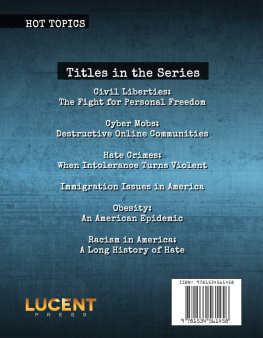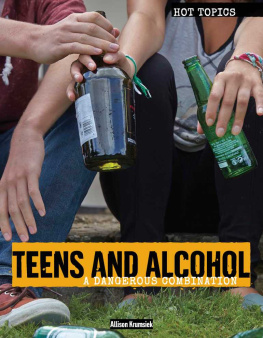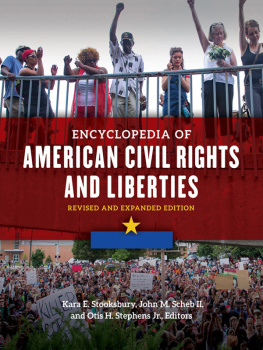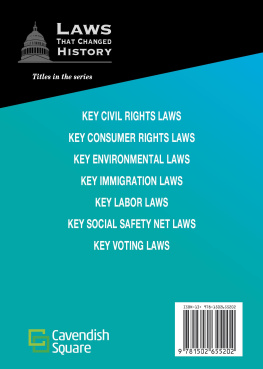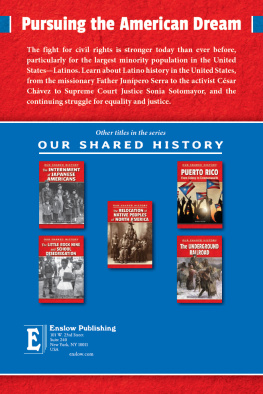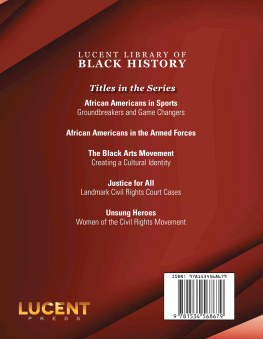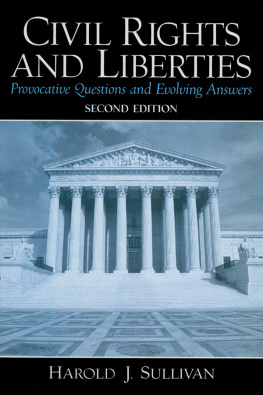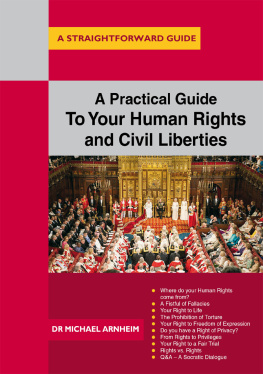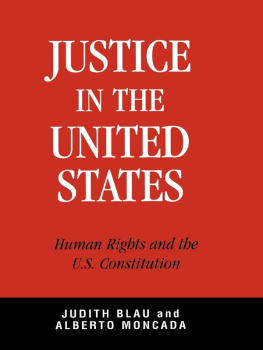Published in 2018 by
Lucent Press, an Imprint of Greenhaven Publishing, LLC
353 3rd Avenue
Suite 255
New York, NY 10010
Copyright 2018 Greenhaven Press, a part of Gale, Cengage Learning
Gale and Greenhaven Press are registered trademarks used herein under license.
All new materials copyright 2018 Lucent Press, an Imprint of Greenhaven Publishing, LLC.
All rights reserved. No part of this book may be reproduced in any form without permission in writing from the publisher, except by a reviewer.
Designer: Seth Hughes
Editor: Jennifer Lombardo
Cataloging-in-Publication Data
Names: Krumsiek, Allison.
Title: Civil liberties: the fight for personal freedom / Allison Krumsiek.
Description: New York : Lucent Press, 2018. | Series: Hot topics | Includes index.
Identifiers: ISBN 9781534561458 (library bound) | ISBN 9781534561465 (ebook)
Subjects: LCSH: Civil rights--United States--Juvenile literature.
Classification: LCC KF4750.K78 2018 | DDC 342.73085--dc23
Printed in the United States of America
CPSIA compliance information: Batch #BS17KL: For further information contact Greenhaven Publishing LLC, New York, New York at 1-844-317-7404.
Please visit our website, www.greenhavenpublishing.com. For a free color catalog of all our high-quality books, call toll free 1-844-317-7404 or fax 1-844-317-7405.
CONTENTS
FOREWORD
INTRODUCTION
Understanding Civil Liberties
CHAPTER 1
The United States and Civil Liberties
CHAPTER 2
Freedom of Speech
CHAPTER 3
Freedom of Religion
CHAPTER 4
Civil Liberties and National Security
CHAPTER 5
Special Population Issues
CHAPTER 6
A Right to Privacy
NOTES
DISCUSSION QUESTIONS
ORGANIZATIONS TO CONTACT
FOR MORE INFORMATION
INDEX
PICTURE CREDITS
ABOUT THE AUTHOR
FOREWORD
A dolescence is a time when many people begin to take notice of the world around them. News channels, blogs, and talk radio shows are constantly promoting one view or another; very few are unbiased. Young people also hear conflicting information from parents, friends, teachers, and acquaintances. Often, they will hear only one side of an issue or be given flawed information. People who are trying to support a particular viewpoint may cite inaccurate facts and statistics on their blogs, and news programs present many conflicting views of important issues in our society. In a world where it seems everyone has a platform to share their thoughts, it can be difficult to find unbiased, accurate information about important issues.
It is not only facts that are important. In blog posts, in comments on online videos, and on talk shows, people will share opinions that are not necessarily true or false, but can still have a strong impact. For example, many young people struggle with their body image. Seeing or hearing negative comments about particular body types online can have a huge effect on the way someone views himself or herself and may lead to depression and anxiety. Although it is important not to keep information hidden from young people under the guise of protecting them, it is equally important to offer encouragement on issues that affect their mental health.
The titles in the Hot Topics series provide readers with different viewpoints on important issues in todays society. Many of these issues, such as teen pregnancy and Internet safety, are of immediate concern to young people. This series aims to give readers factual context on these crucial topics in a way that lets them form their own opinions. The facts presented throughout also serve to empower readers to help themselves or support people they know who are struggling with many of the challenges adolescents face today. Although negative viewpoints are not ignored or downplayed, this series allows young people to see that the challenges they face are not insurmountable. Eating disorders can be overcome, the Internet can be navigated safely, and pregnant teens do not have to feel hopeless.
Quotes encompassing all viewpoints are presented and cited so readers can trace them back to their original source, verifying for themselves whether the information comes from a reputable place. Additional books and websites are listed, giving readers a starting point from which to continue their own research. Chapter questions encourage discussion, allowing young people to hear and understand their classmates points of view as they further solidify their own. Full-color photographs and enlightening charts provide a deeper understanding of the topics at hand. All of these features augment the informative text, helping young people understand the world they live in and formulate their own opinions concerning the best way they can improve it.
INTRODUCTION
Understanding
Civil Liberties
T hroughout history, people have fought to protect their freedom. Sometimes these fights are violent, such as when a government is overthrown by the people. Other times the fights are more peaceful, such as when people circulate petitions and organize protest marches. However, whether peaceful or violent, the aim is the same: to protect basic human rights.
The belief that people are born with certain freedoms is part of a philosophy of natural rights. Philosopher John Locke wrote about this theory in the 17th century. In 1689, Locke published the Two Treatises of Government. He wrote that all people are born with natural rights, such as the right to life, liberty, and property. He believed that a government had no right to take these away. If a government tried to take away peoples freedoms, Locke believed the people should rebel against the government.
In 1776, the American colonists rebelled against the British government because the colonists felt England was violating their civil liberties.
Liberties Historic Beginnings
Civil liberties are natural rights that are free from government interference. Common civil liberties are the freedom of religion, the freedom of speech, the right to a fair trial, and the right to privacy. Governments that support civil liberties make laws to protect them.
The Magna Carta was one of the first documents to protect peoples civil liberties. It was a document issued in AD 1215 that forced the king of England to respect certain rights of his subjects. Even as king, he could not interfere with these rights. One of the rights was habeas corpus, which allowed the kings subjects to appeal against unlawful imprisonment.
Although the Magna Carta protected some freedoms, it did not safeguard religious freedom. Puritans and other religious groups could not worship the way they wanted in England. During the 1600s, many of them left England. They went to America and started the first British colonies there, taking the concept of civil liberties with them.
The creation of the Magna Carta showed that even kings are expected to respect the rights of their subjects.
Exercising Civil Liberties
When the British colonies in America broke free of Great Britain, the Founding Fathers formed a central government, but they structured it so that the government could not violate peoples natural rights. They adopted the Bill of Rights, which specifically states which liberties the government will not violate.

